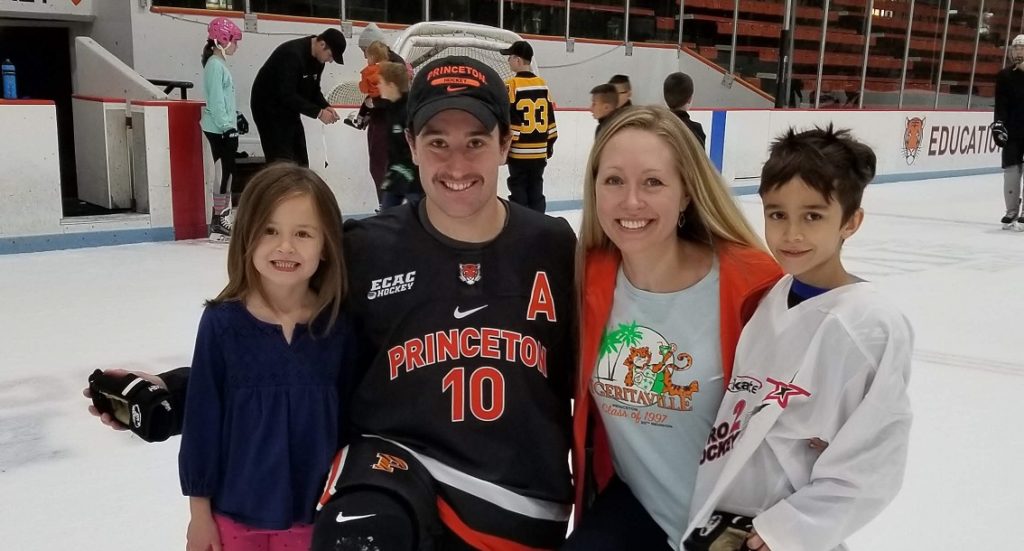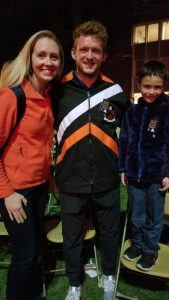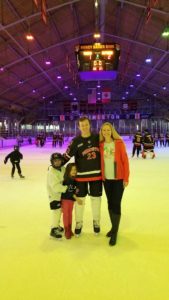
When NCAA alumni and U.S. citizens were white elks in professional hockey, fiction offered the most famous example.
As the Charlestown Chiefs yearbook said circa 1977, Federal League leading scorer and pacifist Ned Braden attended Princeton. While he excelled on the ice, people wondered why someone of his background was in that line of work.
Whether or not “Slap Shot” screenwriter Nancy Dowd meant to underscore a perceived conflict between the Ivy League and ice legionaries, the next generation witnessed an exemplary development in revealing the whole person of student-athlete and university employee to one another.
For roughly a quarter-century, the Princeton athletic fellows program has encouraged faculty and staff to involve themselves with the sports teams as far as the NCAA allows. In return, they help student-athletes to balance a demanding double life and make meaningful time for other enriching aspects of college.
It has been 12 and a half years since Kevin Westgarth, who was more like Dave “Killer” Carlson in his eight-year pro career, last drew the program’s immediate benefits. But the NHL’s current vice president of business development is still feeling its effect.
“The faculty fellows were a great resource during my time at Princeton,” said the psychology major. “Not only were they available for classroom support, but we were able to socialize with them off the ice and away from the rink.”
Women’s head coach Cara Morey calls the result of the fellows program “real Kumbaya-tic.” And as a Brown graduate and ninth-year Princeton staffer, she has an informed gauge on the most time-honored higher-education institutions and their all-round makeup.
“Every Ivy is very different in how they structure everything and how they value athletics and academics,” she said. “At Princeton, they have just gone a great job of setting the bar and making academics and athletics accessible.”
To that point, Princeton is No. 1 in U.S. News & World Report’s 2020 national university rankings, and the criteria go beyond what comes first. The magazine elaborates with six paragraphs on general academics, history, environment, and tuition, followed by athletics, then student life.
Athletic fellows volunteer to facilitate fulfillment on the latter two fronts, and do so in larger units than normal. Of the 67 Division I schools fielding men’s or women’s hockey, only eight mention a faculty or staff advisor/affiliate/fellow/liaison on their online roster. Generally, one or two ambassadors are assigned to work with one team. Others cover the entire athletic department.
At Princeton, 11 fellows are on the men’s hockey support staff, and seven are on the women’s. Besides that credit, they all get a hyperlink to their own profile page on the Tigers website.

“I think it’s a really nice gesture,” said Alec Dun, Princeton’s assistant dean who oversees the fellows program. “And a gesture only means something if it’s to something true and real, and that’s what this is.
“They are affiliated with the team and supporters of the team; more than just fans.”
Princeton’s precedent follows that of the late sociology professor Marvin Bressler, who began his three-decade tenure in 1963. Although he predates the formal fellows program, he is remembered as the “original fellow.” Beyond the lecture halls and boardrooms, he made his mark as an outspoken basketball booster, starting midway through the Bill Bradley era.
Another student from Bressler’s early days, Gary Walters, became Princeton’s athletic director in 1994. He created the fellows program in hopes of fostering more Bressler-esque relationships between faculty and staff, coaches, and their shared learners. Today, with former soccer and hockey star Mollie Marcoux as athletic director, more than 200 employees participate across the 34-team department.
The hockey teams combine for 16 fellows, including two overlaps in economics professor Henry Farber and Whitman College director of studies Jaclyn Schwalm. The men tie swimming and diving for the second-most of any team, surpassed only by football’s 19.
Despite a dearth of banners or flashy alumni, it is hard to ignore the sport’s ties to Princeton’s general tradition. With Hobey Baker and Patty Kazmaier, the Tigers produced the namesakes of the NCAA men’s and women’s player of the year awards. Another alum, Laura Halldorson, was the first coach of the Minnesota Golden Gopher women’s program, an instant and never-waning powerhouse.
In the pros, two Tigers catalyzed the players’ side to help end the last NHL lockout. George Parros, who majored in economics and is now the league’s chief of player safety, and Westgarth promoted peace and salvaged a reduced 2012-13 season.
But neither of those enforcers cut their campus lives short.

Nate Ewell, deputy executive director of College Hockey Inc., attended Princeton early in the Walters era. CHI touts hockey’s regal position on the NCAA’s graduation leaderboard among men’s sports at 92.1 percent (per an October 2014 report).
The organization’s website touches further on “classmates, dorm life and school spirit” that come alongside the puck package. For good measure, it throws in the potential for players to meet “future spouses,” which Westgarth did with women’s hoopster Meagan Cowher.
Through the athletic fellows, Ewell’s alma mater wages one of the more vigorous and visible campaigns for a player’s meaningful immersion and full-length stay. “One of the great benefits of the college hockey experience is the chance to build meaningful relationships with people from all corners of campus,” he said. “Princeton’s faculty fellows program is an exceptional example of how that occurs.”
Yes, the first priority is alleviating schoolwork-sport entanglements incidental to student-athlete life. Athletic fellows are the middle point of the triangle when players must plan ahead or react quickly to keep their commitments compatible.
With hockey, that is especially tricky when crafting a loaded five-course semester to ensure 17 credits in four years. Whereas most sports’ offseasons envelop a full term, pucksters play the majority of their games in the fall term (which ends in January), then the more pressured-filled homestretch and playoffs to start spring. Fellows and other advisors will find them a fix, sometimes in the form of a summer class.
But another part of that relationship means spending almost as much time in the team’s domain as the students spend in theirs. Many fellows capitalize on priority access to rinkside seats at home and periodic invitations to road games, team service outings, and other functions.
Some even join the hockey staffers in pick-up games, and bring ample experience. Trisha Thorme, who works with the women’s program and directs the university’s community-based learning initiative, has played recreationally since the mid-1990s.
Other testaments to the fellows’ puck passion include Schwalm’s lifelong Philadelphia Flyers fanaticism and Farber and social science department chair Christopher Achen hosting former journeyman Blair MacKasey and NBC analyst Pierre McGuire in an on-campus panel concerning “The Future of Professional Ice Hockey.”
In everyone’s book, that built-in familiarity is not a prerequisite to becoming an athletic fellow. Dun values those who “really enjoy the team culture, have a good relationship with the coach.”
Still, he allows, an authentic fervor for the beneficiary’s pastime is “sometimes useful as an entry point.”
Morey concurs, citing casual conversations about the Tigers penalty kill or an individual player’s recent performance as common starters. From there, the topics between fellow and coach or fellow and player can take a scenic drive to other common interests.
Now based in Brooklyn, Westgarth is an hour and a half away from his alma mater, and living proof of the more-than-academics, more-than-athletics shelf life the fellows program lends it.
“It was important to be able to have the casual conversations that helped give weight to our entire school experience, and to not take it for granted,” he said. “It’s a pleasure to still see many at Princeton reunions, hockey games, or alumni get-togethers, catching up, and hopefully allowing them to appreciate the work they do matters.”

As it happens, one men’s team fellow, Cathy Phillips, handles class affairs and reunions. Her family accepts every Skate with the Tigers invitation, and she proclaims her son Owen is “arguably the team’s biggest little fan.”
“I am astounded by the players’ work ethic and dedication,” she said. “Not only are they always striving to be the best during games, but they are having to juggle rigorous academic, practice, and travel schedules. It is an honor getting to know the team and having the opportunity to support them throughout their time at Princeton and beyond.”
In the offseason — both athletic and academic — Phillips has borrowed Ron Fogarty’s pupils to aid in her day job. This past spring, forward Luke Keenan joined the student crew on reunion weekend, which brought an estimated 25,000 guests.
On the other side of the summer break, Morey and her capstone class enjoy another diversion from both halves of the student-athlete label. Their fellows assemble them for a preseason barbecue, challenging them to a Chopped-style competition. The students create the courses, and the staffers determine the winner by presentation, taste, and originality.
“It’s always really special,” Morey said, “because it has nothing to do with anything but human beings interacting.”


